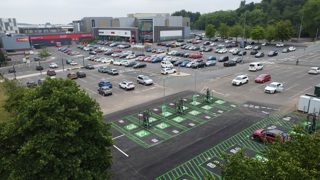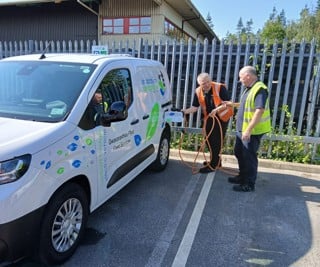Fleets making the transition to electric vehicles are facing a “whole new world” of factors to consider to make the correct steps to manage costs and realise the additional benefits available.
Alex Potts (pictured), head of sales at BP Pulse, took members of the Fleet200 Strategic Network, shared learnings from transitioning its largest customers in the last 12 months, with an emphasis on depot location.
“To go into full transition, we enter a whole new level of health, safety, security and environment and construction design and management regulations to make sure we provide a full and adequate design and build,” Potts said.
“The infrastructure has to be fit for the future because what we’re looking at is 100% electrification, full depot transition, which means we really need to scrutinise the decisions we make to optimise costs.”
Full transition involves a big investment to bring businesses costs of operation down.
He described EV charging as an “iceberg model”, with much of the infrastructure below the surface, in this case, concrete.
While charging points are relatively easy to replace, the electrical infrastructure, civil and energy supply works, Potts warned were difficult, with the challenges growing exponentially when considering multiple charge points on one site, with high power DC charging of 100 – 300 kilowatts for heavier duty or long duty cycle vehicles.
Potts’ three key takeaways:
1. Put the time into collaborating with your infrastructure provider so they give you the best possible option for your business, unique to any other business sector. It will need to spend time learning your business in order to make the correct recommendations
2. Understand your infrastructure to enable your infrastructure supplier to optimise delivery
3. There is no better way to save money than to only dig up your car park or depot once.
Also, assign programme metrics at the beginning of the process: you cost per day, the cost per kilowatt hour deliverable across your site. “If you want to tweak you installation or approach methodology, you will be able to understand the ongoing effects.”
For example, if you want to ‘future proof’ underground trunking by making it bigger – and costing an extra £3 per metre – what is the impact on infrastructure when you want to increase charge point numbers from three to 10 in two years’ time?
And consider your user groups, obviously staff, but also site visitors.
Achieve the above and Potts said you have a design specification, allowing BP Pulse to survey the site ensuring full understanding of your business requirements.
Next steps
1. An electrical surveyor will measure your site and check charge point locations. They’ll ensure you have enough power on site or where it can brought from
2. When bringing in a new power supply consider stepping rights with your local distribution network operator (DNO)
3. Optimise at every stage: at every step of the consultation and of the build consider how costs can be taken out or more value added
4. Share information on the size of EVs that will use the site. This can help inform the charge points locations and marking – and avoid trenches being dug at depot entry and exit points.
Potts said: “We demo exactly where charging vehicles will be positioned, along with the charge points and where power is going to be taken from, to give you comfort that the infrastructure delivery is not going to truncate on-site operations.”
Saving money on power supply
Some sites, Potts said, particularly new build, will have up to and including 300 amp, three phase available. But for older sites, this will not be the case. How do you minimise cost?
“You will have to go to your DNO to bring in power supply and you have the option to use an independent distribution network operator that gets paid for the amount of energy throughput you’re using.
“If you can justify how much energy will be supplied by providing fleet data ie 10 vehicles doing around 100 miles a day, therefore you will require around 80 kilowatts per day per vehicle, that DNO can give you an enhanced asset value for that period.
“So, while you may be looking at a £20,000 cost for a new power supply, we can actually bring back an asset value that is equal to or above the cost of the new supply.”
Another tip was, if you’re site is relatively low on power supply, the local DNO could be persuaded to provide a little bit more. “It’s amazing how often this is the case,” Potts said.
BP Pulse can also match up the half-hourly requirements of your site against the proposed charging requirements.
“Typically your charging will be done at night, while consumption is during the day. So, we can map that and mitigate the requirement for enhanced supply because you’re using it at different times.”
Potts said there were costs savings through using a supplier that can do direct procurement of of more technical infrastructure such as feeder pillars, rather than going through electrical wholesalers, which can add 20% to costs.
BP Pulse would want a handover pack that fits all the requirements of your HSSE and property personnel for insurance purposes.
The company is also able to provide a feasibility study based on fleet telematics data, pre-installation to ensure charging infrastructure will meet the fleet needs.





















Login to comment
Comments
No comments have been made yet.